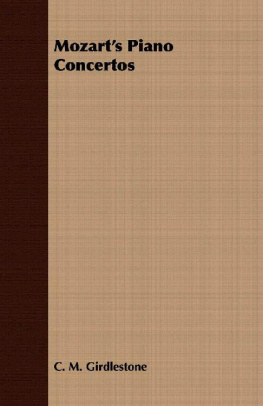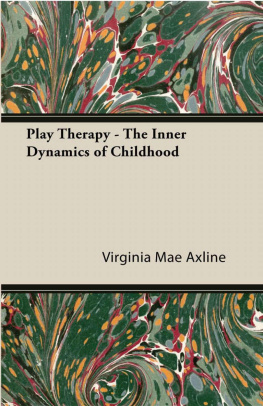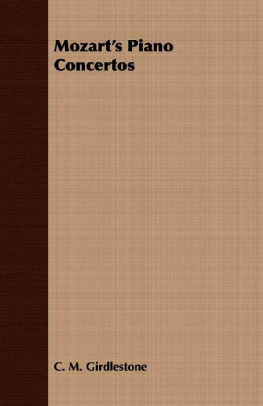MOZARTS PIANO
CONCERTOS
C. M. GIRDLESTONE

MOZARTS PIANO CONCERTOS
To
Dame Myra Hess
Contents
Preface
I HAVE attempted in this book a study of Mozarts piano concertos. This important part of his work has never received the attention it deserves and, until within the last few years before the war, orchestras and executants had neglected most of his great concertos, whereas less personal compositions, such as his piano sonatas and trios, were known to everyone. The only studies of his piano concertos, at the time when this book was written, were those found in works dealing with him or with the genre as a whole, such as those of Abert or Engels, No study had been devoted to them exclusively.
I have sought to observe the growth of Mozarts form and inspiration throughout his twenty-three piano concertos. From one period to the next, sometimes from one work to the next, I have sought to understand the unfolding of his art by using the piano concertos as landmarks in my journey. Their importance in the history of music is generally recognized; there remained to define their part in his work as a whole.
I have insisted perhaps a little more upon the growth of his inspiration than upon his technique. But as in the last resort the two are inseparable, both have their share in these pages. Moreover, as it is arbitrary to isolate this or that category of an artists work from its context, I have related the concertos to the most representative of his other compositions.
My aim has been to follow the unfolding of his genius throughout his piano concertos and to give them their place in his work. It is not for me to judge with what success this aim has been attained; it is enough that there should be no doubt of the excellence of the aim itself.
I would like to thank the Principal of the Royal College of Music for permission to reproduce a page of the MS. of the C minor concerto which is preserved in the College library, and M. le Conservateur of the Rodin Museum in Paris for allowing me to reproduce Rodins Mozart. It is perhaps not generally known that the model for this imaginative interpretation of our composer is none other than Gustav Mahler.
In making an English translation of this book, the original of which appeared in French in 1940, I have shortened a few passages and corrected a few mistakes in the examples. The chief change in the text concerns the remarks on about the origin of the sonata rondo.
C. M. G.
January 27, 1948.
H. Engels: Die Entwicklung des deutschen Klavierkonzerts von Mozart bis Liszt (Leipzig, 1927).
H. Abert: Mozart (Leipzig, 191921).
Fr. Blume: Die formgeschichtliche Stellung der Klavierkonzerte Mozarts (Mozart Jahrbuch, II, 1924).
PART I
1. Introduction
THE twenty-three concertos that Mozart wrote for his favourite instrument play, in the history of their genre, a part comparable to that played by Beethovens nine masterpieces in the history of the symphony. Just as Beethovens works established the form of the symphony for nearly a century, so Mozarts piano concertos, owing to their number and the great beauty of most of them, were at the source of the modern concerto and laid down the lines along which it was to develop for many years. The structure of most concertos of the last century is fundamentally the same as that of his own and even modern works show proof of his influence.
Mozart has enriched the concerto form with a larger number of masterpieces than any other of the great composers. In the work of most of them concertos have occupied but a small place, much smaller than that held by symphonies or quartets. With him, on the other hand, they are more numerous than any other kind of composition except symphonies, and he has left in all some forty for instruments or groups of instruments of all kinds. The partial neglect of the form by most of the masters has thrown his into greater prominence, especially those which he wrote for the piano.
Nevertheless, for the music-lover who is less concerned with the history of the form than with the personality of each work, with the thought that inspires it and the joy it gives, his twenty-three concertos are still more precious. They are an inexhaustible spring of delight. Their diversity corresponds to our most varied moods, from the state of quiet content in which all we ask of art is entertainment, exquisite rather than deep, the exuberance of animal spirits, the consciousness of physical and moral health, to melancholy, sorrow and even revolt and to an Olympian serenity breathing the air of the mountain tops. The comparative uniformity which we notice between them at first sight disappears with closer scrutiny. The feeling is never the same from one to the other; each one is characterized by a personality of its own and the variety of their inspiration shows itself ever greater as we travel more deeply into them.
Thanks to this variety, Mozart is one of the few composers who can become ones daily bread. Formal diversity matters little; what we demand is diversity of inspiration. Many composers have a more varied form than he and yet their work, when we steep ourselves in it, soon brings on a tedium which his greater works never cause and from which we suffer only when we persist in studying him in compositions where he did not express his full being.
It is this privilege of giving lasting satisfaction to mind and spirit, even more than their historical importance, that causes his concertos to rank among the masterpieces of their art. We shall therefore seek above all to discover the inner character of each one of them and the nature of the emotion which makes it what it is. Formal study cannot be neglected, however, for form is never separable from matter and formal analysis often reveals beauties of an emotional order. Formal studies exist already but no one has attempted to show how rich and deep is the inspiration of these works. The tendency has been rather to underestimate their inspirational value, to consider them as drawing-room music, and to put them below his symphonies and chamber music. We hope to show that they deserve a higher place and represent as worthily and as fully as these the personality of their creator.
Not only in the work of Mozart but in general, musical critics have been inclined to deny the concerto an exalted position and to regard it as an inferior genre, unworthy to stand beside the symphony. Such an attitude is seen in definitions like that of Ebenezer Prout in the first edition of Grove
Similar definitions are still current and depreciate the genre by accusing it of placing the executants muscular agility and his vanity above artistic expression. They are just when they apply to the virtuoso concertos of certain soloist composers, but it is unfair to take the poorest representatives of a form as its models. Mozart, Beethoven, Schumann, Brahms, Franck never devoted their genius to satisfying the vanity of a virtuoso, to helping an executant to show his skill. The numerical preponderance of bad concertos is alone responsible for these definitions; there lies the reason why the mass of the public, when it hears a concerto, whatever be its value, admires first of all the accomplishments of the soloist, and why the meaning of its applause is less How beautiful this music is! than What a lot of notes this performer gets in!
The essence of the concerto lies in the struggle between the orchestra on one hand, and the solo instrument, or group of instruments, on the other. The struggle is broken by truces during which orchestra and solo collaborate on friendly terms, and it ends with a reconciliationbut it is none the less a struggle. Sometimes the weapons are common to both sidesthe main themes which return in solos and tuttis; sometimes each side has its ownthemes reserved for the solo and others that belong to the orchestra. There are vicissitudes; the strife may remain indecisive, and solo and orchestra may toss the chief subjects from one to the other; the tutti may win a momentary victory and loudly proclaim its triumph, or the soloist may see his endeavours carry the day by dint of chords, scales and arpeggios, and spurn the vanquished orchestra with a series of scintillating trills. But, whatever the temporary issue, we know that in the long run neither side will win and that the final cadence will conclude peace and alliance between the former adversaries.





